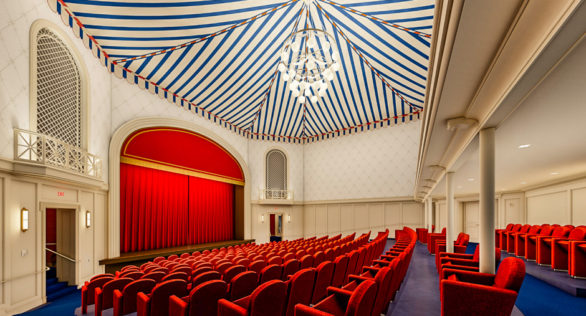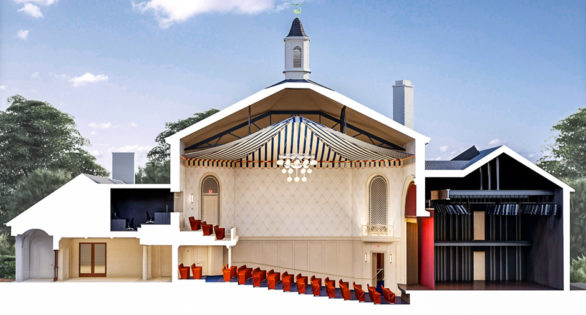
~~~~~~~~~~~~~~~~~~~~~~~~~
GUILD HALL ANNOUNCES PLAN FOR 21ST-CENTURY RENEWAL
OF THE JOHN DREW THEATER AS PART OF FACILITY-WIDE
CAPITAL IMPROVEMENTS PROJECT AND CAMPAIGN LAUNCHED IN 2021
————————-
Spearheaded by Peter Pennoyer Architects in consultation with Auerbach Pollock Friedlander,
the plan outlines architectural and technological improvements for unparalleled performer and
visitor experiences, inspired by the original 1931 theater design
The updated theater will be inaugurated in winter 2023/24, following
the summer 2023 reopening of Guild Hall’s building at 158 Main Street
~~~~~~~~~~~~~~~~~~~~~~~~~

Architect’s rendering—technical systems omitted for clarity. © Peter Pennoyer Architects
——————————–
East Hampton (December 15, 2022)—Guild Hall today shared the design plans for its John Drew Theater, as part of the multi-arts center’s comprehensive improvements that commenced earlier this year. Overseen by the award-winning Peter Pennoyer Architects, a leader in the renovation and preservation of historic architecture, in consultation with globally-recognized theater design experts Auerbach Pollock Friedlander, the plan creates new capabilities for the 1930s-era performance space. The John Drew Theater hosts up to 150 presentations annually, including theatrical productions, dance, concerts, screenings, comedy, talks, and emerging forms. Modernizing the systems and technologies that support this volume and variety of programs will support Guild Hall’s ongoing service to the community. Completion and reopening of the theater is expected in winter 2023/24. The renewed theater comprises an essential part of Guild Hall’s facility-wide capital improvements project and campaign, which was first announced in 2021 and ushers in a period of 21st-century revitalization for the legendary multi-arts center.
————
Andrea Grover, Guild Hall Executive Director, said: “Guild Hall is a special institution founded on the principle that the arts bring communities together. After 91 years of continuous delivery on our mission, we are making our theater, museum, and education space responsive to the innovative presentation needs of today’s artists with the latest tools and technologies. Our upgraded facility will offer a truly exceptional audience experience.”
————
Peter Pennoyer Architects (PPA), whose recent work includes the design of the clock of the new Moynihan Train Station in New York City, is overseeing Guild Hall’s capital improvements plan, including the renewed design of the John Drew Theater. Striking a balance between innovation and preservation, the new design will bring the theater’s functionality up to contemporary performance needs while maintaining key elements of its historic design; this includes, for instance, the restoration of the stage’s scalloped proscenium frame, part of the theater’s original design by Aymar Embury II and only recently uncovered during structural exploration. The theater’s much-beloved circus-tent ceiling motif and iconic balloon chandelier will remain; non-original elements including moldings and wallcovering will be updated to more closely reflect the theater’s elegant 1930s design.
The flow of the theater will also be restored by the removal of non-original doors at the entrance to the theater corridor. In a nod to Embury’s original architecture, columns will be reintroduced in the lobby, recreating the graceful procession from the entrance arcade of the building, through the house of the theater. Space previously taken up by boxes and the technical control booth at the rear of the theater will be repurposed to allow for easy and fully accessible circulation. The plan will implement a new seating arrangement that captures prime orchestra seats, adds greater row-to-row depth, offers broader and more comfortable seating, and enhances sightlines through an increased floor rake.
Notably, the plan includes new technical systems throughout the theater and support spaces, including a relocated control booth in the balcony. The project’s theater consultant Auerbach Pollock Friedlander (APF) has an extensive portfolio that includes Brooklyn Academy of Music’s Gilman Opera House and Harvey Theatre and Carnegie Hall’s Zankel Hall. APF’s plan will advance all audio-visual technologies, lighting, and acoustics for the demands of Guild Hall’s all-embracing performance types.
————
PPA Principal Partner and fellow of the American Institute of Architects Peter Pennoyer said: “This renovation recaptures and burnishes the best of Guild Hall’s original theater. The delight and charm of the circus tent will continue to shine, as improved accessibility, seating, and sightlines for the audience are integrated into the space.”
————
The renewed John Drew Theater is among several core components of Guild Hall’s capital improvements project and campaign to reimagine its 158 Main Street facility for 21st-century audiences. Led by PPA in collaboration with Hollander Design | Landscape Architects, renovation of Guild Hall’s museum, education center, administrative offices (redesigned by Arrowstreet, a specialist in work environments), landscape and gardens is currently underway. These spaces are expected to reopen in summer 2023 with a dynamic program of onsite exhibitions and educational programming, in addition to special off-site programs, following the success of this year’s first Guild Hall: Offsite initiative, which brings the arts to a range of accessible venues on the East End.
Launched with an early goal on the occasion of Guild Hall’s 90th anniversary in 2021, and since met with enthusiastic support, the arts center’s now $29 million campaign also includes dedicated capabilities for advancing the institution’s trailblazing arts program and its vital reserve fund. As of December 2022, Guild Hall has reached 55% of its goal, thanks to the generosity and support of the arts center’s Board of Trustees and supporters.
————
Guild Hall Board Chair Marty Cohen said: “This plan is integral to accomplishing our goals for the renewal and revitalization of Guild Hall: to honor the past, invest in the present, and advance our vision for the future.”
————
Details of Guild Hall’s summer 2023 season will be released in the coming months. Inaugural programming for the John Drew Theater, set to reopen in winter 2023/24, will be announced closer to the date. More information on programming can be found via Guild Hall’s website and e-newsletter.
——————————–
GUILD HALL’S CAPITAL IMPROVEMENTS PROJECT

Architect’s rendering—technical systems omitted for clarity. © Peter Pennoyer Architects
In spring 2022, Guild Hall embarked on a comprehensive renovation to its near century-old site, aimed at creating a state-of-the-art facility that meets the needs of artists and performers, visitors, and staff today and into the future.
In addition to the planned improvements to the John Drew Theater, the capital project will expand Guild Hall’s shared public spaces, including a remodeled lobby and visitor arrival sequence, with priority given to improved accessibility, function, and lighting. The landscape design will significantly enhance Guild Hall’s grounds, including its existing parking spaces, for safety, efficiency, and sustainability. It will add to the existing tree canopy, transition gardens, green spaces, and native plants and grasses, as well as upgrade stormwater drainage systems to substantially improve Guild Hall’s ecological footprint. The addition of terraced seating in the Frieda and Roy Furman Sculpture Garden will enrich opportunities for outdoor arts programming.
Guild Hall’s museum presents exhibitions by innovative contemporary artists from the region and beyond, with additional showcases of the art center’s permanent collection of nearly 2,400 artworks. As part of the capital improvements plan, the museum will see expanded galleries, with increased wall space for the display of art and heightened entry clearances to accommodate today’s artists practicing across a range of disciplines, media, and scales, and their most ambitious works. The galleries will be redesigned for optimal flexibility and flow, and the space outfitted with state-of-the-art sound and lighting systems to ensure greater sustainability and versatility; this includes the transition to LED lighting, and the innovative repurposing of the building’s original, recently uncovered lowlight windows. The HVAC system will likewise be optimized to enhance control, airflow, and energy efficiency throughout the museum, as well as the theater and operational spaces.
The project will create Guild Hall’s first discrete art-handling facility to support the installation, packing, and temporary storage of artworks, a recommended feature for formally accredited members of the American Alliance of Museums. In addition, Guild Hall’s Boots Lamb Education Center – home to its Teen Arts Council, as well as art workshops and drop-in classes for local students – will be upgraded with the latest technological tools to enhance youth training and education. Neighboring administrative offices will be reimagined to ensure a thriving, collaborative environment that is representative of new directions in professional work spaces, including the recent creation of a lightwell in the front of the building, which will bring much-needed natural light into the office spaces.
Renovation is currently underway to Guild Hall’s museum, education center, administrative offices, and gardens, which are expected to reopen in summer 2023. The John Drew Theater will reopen in winter 2023/24.
Project construction is led by premier East End general contractor Ray Harden, co-owner of Ben Krupinski Builder, with Jon Maass and Pamela Torres as owner’s representatives. The design, construction, and advisory team also includes Auerback Pollock Friedlander, Conceptual Lighting, Arrowstreet, 2×4, Leonard Ackerman, and Twomey, Latham, Shea, Kelley, Dubin & Quartararo LLP.
—————————–
GUILD HALL
Guild Hall is the cultural heart of the East End: a museum, performing arts, and education center, founded in 1931. We invite everyone to experience the endless possibilities of the arts: to open minds to what art can be; inspire creativity and conversation; and have fun. For more information about this and other programs, visit guildhall.org.
Instagram: @guild_hall | Facebook: Guild Hall of East Hampton | Twitter: @GuildHall
—————————–
PETER PENNOYER ARCHITECTS
Peter Pennoyer Architects (PPA) is a 50-person firm of architects, interior designers, and related professionals which has been recognized with many design awards and is included in the AD 100, Architectural Digest’s list of top architects and designers. Peter Pennoyer, who is a Fellow of the American Institute of Architects, has co-authored 5 books on architectural history and lectures widely on design. Founded in 1990, PPA is recognized as a leader in new construction, renovation, and historic preservation for residential, commercial, and institutional commissions across the United States and abroad. The firm’s work is characterized by sophisticated detail, high quality craftsmanship and a nimble balance between comfort, beauty, modernity and continuity with the past. With four partners and an array of talented associates PPA’s design tools span from hand drawing, to 3D visualization, to Virtual Reality to 3D printing.
Institutional projects have included the Paul Nitze Center at the Hotchkiss School, the headquarters of Historic Hudson Valley and the offices and library of the New York Genealogical and Biographical Society. Current projects include adaptive reuse of an historic mansion in Savannah, Georgia for Ralston College and a new mid-rise apartment building in New York City.
—————————–
AUERBACH POLLOCK FRIEDLANDER
Founded in 1972, Auerbach Pollock Friedlander (APF) is a globally-recognized theater design and audio-video consulting firm with an extensive portfolio of award-winning projects. The firm’s holistic approach to design lends itself to a wide range of projects that includes performing arts educational facilities, opera houses, professional repertory theaters, concert halls, museums, and planetariums as well as popular entertainment venues in theme parks, casinos, cruise ships, and nightclubs. Their expertise is provided as part of a collaborative process with the larger design team. APF designs for a diverse audience with a diverse team of staff and owners. They have completed projects throughout the world and are adept at creating inclusive and culturally sensitive solutions. Their audience is the world, and they ensure that everyone feels welcome.
APF’s principals and staff have backgrounds in programming, planning and architectural design as well as hands-on experience in theater production design, technology, media arts, sound, video and communication, technical management, and scenography. This depth of experience enables them to provide comprehensive, innovative design, and superior technical solutions that respond to the needs of the end-user while providing the architect with the flexibility to develop their vision. The firm can provide services in initial planning and programming, theater space design, specification of all theatrical and audio-video systems as well as construction administration services
During initial project phases, they engage with the users, operations staff and management to understand their aspirations and concerns and develop solutions that are economically feasible and operationally beneficial.
APF takes the same approach with the audience so that they can create spaces that educate, entertain, are patron friendly for various demographics and form lasting positive memories.
—————————–
HOLLANDER DESIGN | LANDSCAPE ARCHITECTS
Hollander Design | Landscape Architects is a New York-based firm known for designing estates and gardens around the world. Principal Edmund Hollander is recognized for finely crafted landscapes from the Hamptons to Hong Kong. The firm has recently completed the new award-winning additions to The John F. Kennedy Center for the Performing Arts in Washington, DC, as well as the Winter Visual Arts Center at Franklin & Marshall College in Lancaster, PA. The firm’s talent comprises 25 landscape architects, environmental planners and horticulturists working across three offices in New York City, Sag Harbor, and Chicago. The firm’s approach to a site’s natural ecology, its architectural ecology, and its human ecology – meaning the ways in which people will use the property – creates places of enduring beauty that respect and connect with the surrounding environment.
—————————–
BEN KRUPINSKI BUILDER
Stratton Schellinger and Ray Harden became owners of Ben Krupinski Builder (BKB) in 2018 having worked with the firm for 31 years and 16 years respectively. With a track record for hands-on project management, the long-time associates have been instrumental in growing BKB into the region’s premier builder and general contractor. Priding themselves on achieving the finest results, they share a mutual passion for delivering consistent excellence to each client and every scope of the project.
—————————–
JON MAASS AND PAMELA TORRES
Jon Maass is an architect, builder, and maker of things. Jon received degrees from the University of Michigan and the Cooper Union for the Advancement of Science and Art in New York, where he was amongst the first recipients of the Menschel Fellowship. His history of designing and building structures informs and supports his work as an owner’s representative, helping numerous cultural institutions realize new mission-driven projects and restore important cultural touchstones. His work is process driven, emphasizing proper planning at the project’s outset and relentless pursuit of its stated goals. Past clients include the Toledo Museum of Art, the Solomon R. Guggenheim Museum in New York, the Isabella Stewart Gardner Museum in Boston, the John F. Kennedy Center in Washington D.C., the Morgan Library and Museum in New York, the Gustav Stickley Museum at Craftsman Farms, Smith College in Northampton, MA, and the Museum of Nebraska Art.
Pamela Torres has a master’s degree in Advanced Building Technology from SUNY Buffalo New York and holds a Bachelor of Science in architecture from the University of the Philippines. She is an architect who worked on a wide range of projects with architecture and design firms in New York, Miami, Boston, Shanghai, and San Francisco before transitioning to owner’s representation and project management. Notable experience includes the SANAA-designed Grace Farms community place in New Canaan, Connecticut, and the exterior restoration of the Solomon R. Guggenheim Museum in New York.
—————————–
Guild Hall
158 Main Street, East Hampton, NY 11937
—————–
================================================
AAQ / Resource: Ben Krupinski Builder
______________________________________________________________________

